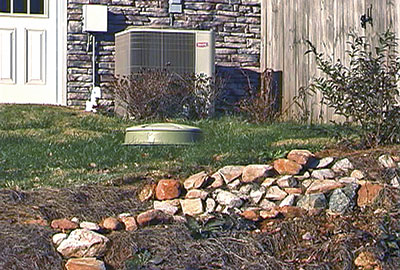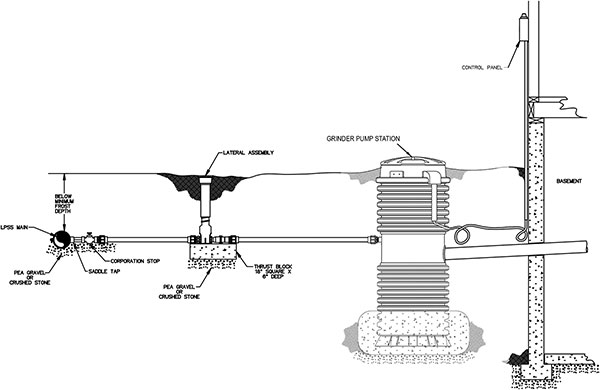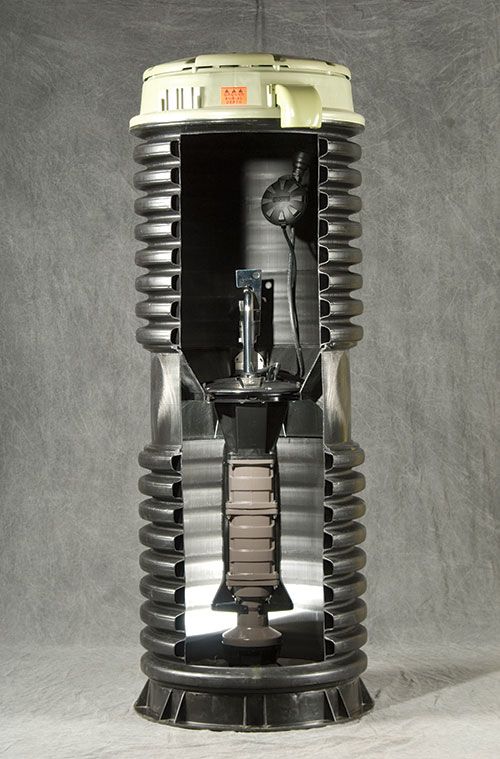Basement flooding caused by sewer backups is damaging, expensive and common in towns and cities throughout the U.S. In addition to being a health hazard and a stressful event for building occupants, sewer backups cause a tremendous financial burden. Grinder pumps provide protection and security to homeowners and businesses by preventing sewer-related basement flooding.
System Types
There are two general types of sewer systems, both of which can result in overflows into residences and businesses when they are surcharged. Sanitary sewer systems are designed to convey domestic and industrial wastewater to sewage treatment plants. Combined sewer systems, predominantly located in the Northeast, Northwest and Great Lakes regions of the U.S., are designed to transport stormwater and sanitary flow.
In sanitary sewer systems, overflows are often attributed to excessive groundwater or rainwater entering the system as infiltration and inflow (I & I). In combined sewer systems, overflows often result from an insufficient capacity to properly convey the combined sanitary and wet-weather flow.
Overflow
Whether as a result of system deterioration, blockages, breaks in sewer mains, poor maintenance practices, insufficient capacity or other factors, both sanitary sewer overflows and combined sewer overflows can occur regularly in municipal wastewater systems. Overflows of sewer systems occur when the volume of water in the system is greater than the carrying capacity of the pipe.
 Image 1. A grinder pump station access lid
Image 1. A grinder pump station access lidThe extraneous water—the volume above the design capacity of the pipeline—surcharges the system. This hinders the forward flow of the wastewater, causing the water level in the system to back up into manholes and private service laterals. When the surcharged flow in the system rises to an elevation higher than the elevation of manholes, cleanouts and building fixtures, the excess wastewater overflows to the environment. In the case of basement flooding, these overflows will often occur through drains, toilets and other fixtures in basements. Because of the confined nature of the overflow, decreased chance of dilution and increased chance of human exposure, basement overflows are generally a greater concern than other types of sanitary sewer overflows.
Backflow Prevention
A common approach for preventing basement flooding is the installation of a backflow prevention valve system. A backflow prevention valve system is a mechanical device installed on the 4-inch outlet pipe between the building and the mainline sewer. Both automatic and manual backflow prevention valve systems are available, either flapper check-type or gate-type styles. Under normal operation, the backflow prevention device allows sewage to flow out of the property, but does not allow the sewage to flow back into the building from the municipal sewer during surcharged conditions.
A critical operational characteristic of a backflow prevention system is that the valve is designed to be closed, stopping the flow of wastewater. While offering some protection from sewage flowing back into private property, when the device is activated in the closed position, wastewater from the property cannot be discharged. Toilets, sinks, showers, washers, dishwashers or any appliance that discharges wastewater should not be used.
Wastewater from the internal plumbing system will not be able to flow out through the backflow prevention valve. Continued use of water when the backflow prevention valve is activated could result in flooding from the building’s own wastewater. The constraint imposed by limited use of the facilities yields a less than satisfactory solution, especially during extended periods of wet-weather events and surcharged sewer conditions.
An additional concern with backflow prevention valves, particularly the flap gate type, is that they can become clogged with debris. When this occurs, the valve will fail to close completely. The backflow of sewage from the surcharged sewer will be slowed but will not be stopped completely in these instances.
For this reason, many municipalities have determined that advising property owners to install backflow preventers using flap gates provides limited protection against basement flooding and should not be depended upon.
 Figure 1. Typical grinder pump installation
Figure 1. Typical grinder pump installationMunicipalities are also incorporating low-pressure sewer systems into their basement flooding prevention programs. While typical solutions—such as backflow prevention valves—provide isolation of private properties from the sewer, no “moving force” conveys the household wastewater to the surcharged gravity sewer system during wet-weather events. While providing some protection from basement flooding, the use of the property is limited because of the inability to discharge wastewater. Unlike the typical solutions to prevent basement flooding, a grinder pump station provides pressurized positive flow. This results in a positive isolation of flow from the surcharged sewer, but also provides the ability to pump against a surcharged system, allowing for uninterrupted use of the residence or business. Grinder pumps collect the wastewater from the residence or business and grind the solids into small particles. At each home or business site, a grinder pump station is installed in the ground, with an access lid for service.
These pump stations—which are smaller than a washing machine—grind the waste into a fine slurry and pump it under pressure into small diameter pipes that lead uphill or horizontally to an existing sewer main. Because of the pressure generated by the pumps, they can move sewage nearly 185 feet vertically or up to two miles horizontally.
 Image 2. Wet-well/drywell design
Image 2. Wet-well/drywell designOakland County Water Resources Commissioner
The Evergreen-Farmington Sewage Disposal District (EFSDD) is a regional sewer service district within the Detroit Water and Sewerage Department (DWSD) service area that provides sanitary sewer service to all or a portion of 16 communities in Oakland County, Mich. The Oakland County Water Resources Commissioner (WRC) owns, operates and is responsible for all maintenance, operation and administration of the major sewer facilities in the district—such as interceptors and some pump stations’ sewers that serve the EFSDD. Local sewer facilities, however, are maintained by each municipality.
Most of the EFSDD is served by separated sewers, with less than 1 percent of the service area served by combined sewers. Lathrup Village, a member community of the EFSDD, operates its own separated sewer system and constructed equalization basin. Wastewater from the Lathrup Village service area discharges to the Evergreen Interceptor, one of two major interceptors within the district. The flow is ultimately conveyed to the DWSD wastewater treatment facilities. The Lathrup Village Equalization Basin is located on the western boundary of the area, adjacent to the interceptor. The equalization basin has a capacity of three million gallons and serves the Lathrup Village service area. During normal or dry-weather flow, wastewater from the service area bypasses the basin and is pumped to the Evergreen Interceptor. During wet-weather events, when flows exceed approximately 3.3 cubic feet per second, the excess flow above that threshold is diverted to the equalization basin.
Although the basin provides equalization of the wet-weather flows, the sanitary sewer upstream from the basin is subjected to surcharged conditions during these events.
Sanitary sewer overflows have historically occurred near the terminus of the wastewater collection system, adjacent to the equalization basin on Rainbow Circle.
Lathrup Village installed grinder pump stations at 14 residences on Rainbow Circle (see Image 2). These stations are capable of overcoming the high backpressure in the sanitary sewer and protect the homes that are prone to basement flooding.
Conclusion
As with many best practices, a grinder pump station is a simple and straightforward solution to a situation that has plagued communities with gravity sewers for decades. With this technology, thousands of utility districts can deliver relief to their low-lying constituents and avoid the costly cleanups and litigations that can result from sewer backflows.

